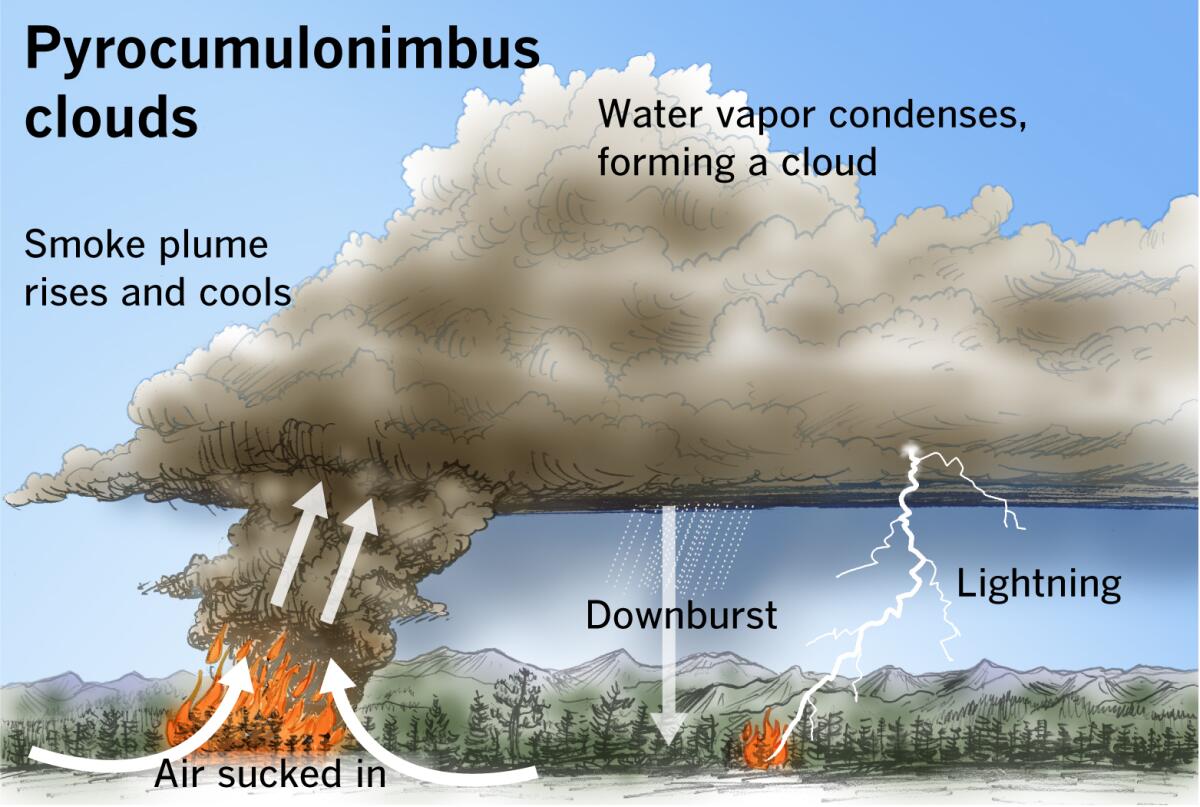Good morning. It’s Monday, Sept. 9. Here’s what you need to know to start your day.
Newsletter
You’re reading the Essential California newsletter
Our reporters guide you through our biggest news, features and recommendations every morning
You may occasionally receive promotional content from the Los Angeles Times.
Expect smoky air, thunderstorms and persistent heat as fire weather blankets SoCal
Southern California’s oppressive, record-breaking heat wave is awful enough on its own. But residents across swaths of the Southland now face a compounding threat: the massive Line fire in San Bernardino County, which is burning so hot that it has produced its own thunderstorms.
That’s creating even more risks for communities in and near the San Bernardino Mountains as regional officials warn of hazardous smoke, lightning strikes, hail, strong winds and potential flash floods.
“Los Angeles County and surrounding areas are under a red flag warning as temperatures are expected to reach more than 100 degrees in some parts,” my colleagues Teresa Watanabe and Colleen Shalby reported Sunday. “The combination of high heat and humidity will bring a chance of thunderstorms across the mountains of Los Angeles, San Bernardino and Ventura counties, and the Antelope and San Gabriel valleys.”
A motorist has the Line fire in their rearview mirror as the blaze jumps Highway 330 on Saturday near Running Springs, Calif.
(Eric Thayer/AP)
Here are the basics as of this morning:
- More than 20,500 acres have burned
- The fire is 3% contained
- More than 36,000 homes and other structures are threatened
- 1,855 personnel are assigned to the fire
- Three firefighters have been injured
Evacuation orders were in place for Running Springs and Arrowbear Lake, and evacuation warnings were issued Sunday for Lake Arrowhead, Cedar Glen, Crestline and Valley of Enchantment.
Fire officials said Sunday that their efforts had been challenged by erratic wind conditions, smoky air and limited resources.
Another major complication for firefighters and everyone else: pyrocumulonimbus clouds. The fire-triggered storm clouds produce lightning that grounds firefighting aircraft and could spark more blazes. And these fire clouds are forming more frequently, according to researchers.
“Hot and dry conditions mixed with thunderstorms are expected to challenge firefighters for the next few days,” they wrote on a public information webpage.
National Weather Service officials in San Diego said they had recorded more than 3,700 lightning strikes inside the clouds and over 280 ground strikes on Saturday alone.

A pyrocumulonimbus is the ultimate extreme pyrocumulus cloud.
(Paul Duginski / Los Angeles Times)
“Pyrocumulus can cause additional complications when it comes to fighting the fire, creating gusty and sudden wind shifts, along with large amounts of [lightning] … and even rain,” officials noted on X this weekend.
That led the NWS to issue several flash flood warnings, including for some parts of Riverside, San Bernardino, Fontana and Rialto.
The Line fire reportedly started in the city of Highland in an area where tract housing meets the foothills of the San Bernardino Mountains.
Areas like that, known as the wildland-urban interface, are highly prone to wildfires. The cause of the blaze is under investigation, but the point of origin brought to mind a conversation I had last month with Seth Mitchell, a deputy forest fire management officer with the U.S. Forest Service.
Mitchell noted that, contrary to public perception, “the majority of wildfires start on private land and move into forested areas,” not the other way around.
Another wildfire sparked nearby Sunday
Firefighters faced a separate wildfire Sunday that broke out in the Angeles National Forest north of Glendora in L.A. County.
Dubbed the Bridge fire, it had burned 800 acres and was 0% contained as of Sunday evening.
Forest visitors were being evacuated from the area, and several roads were closed, including East Fork Road, State Route 39, Glendora Mountain Road and Glendora Ridge Road.
Forest officials said firefighters were performing an “aggressive attack with air and ground resources.”
California faces an explosive fire season after a mild couple of years
We’re at peak fire season in the West, and this year has been notably busy compared with the previous two seasons, which were tempered by back-to-back wet winters.
According to Cal Fire incident data, roughly 838,575 acres have burned so far this season. That’s more than in 2022 and 2023 combined.
Although fires are part of our forests’ natural ecosystem, human-caused climate change and roughly a century of flawed forest management have greatly increased the risks that wildland fires will explode into the massive infernos we’ve seen happen more frequently in recent years.
For updates Monday on the Line fire, Bridge fire and other fire weather hazards, you can follow the L.A. Times’ coverage. You can also check for updates from the National Weather Service in Los Angeles or San Diego, and from officials with the Angeles National Forest and San Bernardino National Forest.
Today’s top stories

California Gov. Gavin Newsom.
(Kent Nishimura / Los Angeles Times)
Politics and power
Climate and environment
More big stories
Get unlimited access to the Los Angeles Times. Subscribe here.
Today’s great read

Steve Serio of the U.S. celebrates Saturday after winning the wheelchair basketball men’s gold medal game at the 2024 Paralympics in Paris.
(Thomas Padilla / Associated Press)
Attendance and TV viewing figures from the Paris Paralympics have been encouraging. Could L.A. 2028 help take Paralympic sports to the next level? Athletes and officials shared their optimism with The Times’ David Wharton. “After decades of fighting for attention, they feel poised to emerge from the shadow of their older, more-glamorous sister,” David wrote.
How can we make this newsletter more useful? Send comments to essentialcalifornia@latimes.com.
For your downtime

Bburinkle chicken from BHC restaurant in Koreatown.
(Jenn Harris / Los Angeles Times)
Going out
Staying in
And finally … a great photo
Show us your favorite place in California! We’re running low on submissions. Send us photos that scream California and we may feature them in an edition of Essential California.

McArthur-Burney Falls Memorial State Park is seen in October 2015.
(Kevin Brady)
Today’s great photo is from Kevin Brady of Albuquerque: beautiful McArthur-Burney Falls Memorial State Park in Shasta County.
Have a great day, from the Essential California team
Ryan Fonseca, reporter
Amy Hubbard, deputy editor, Fast Break
Check our top stories, topics and the latest articles on latimes.com.

